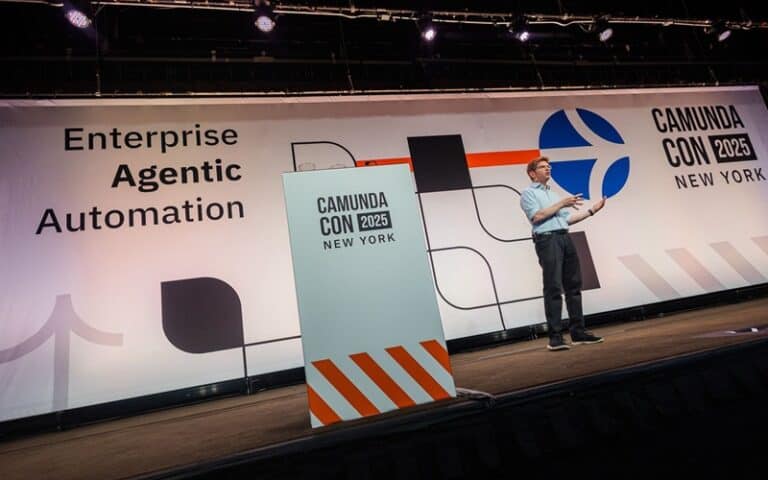All those (AI) agents need management, automation, scalability control, maintenance, testing and orchestration. This was the central remit that CamundaCon set out to explore. Camunda’s process orchestration and automation conference was held this month at the Sheraton New York Times Square Hotel. With end-to-end orchestration in its sights, did the company manage to deliver on its promise of “AI with no BS” (as the banner read on the hotel exterior) or would this event fuel more of the AI hype-cycle?
An opening keynote address entitled Building the AI-Driven Enterprise with Agentic Orchestration was delivered by Jakob Freund, CEO, Camunda and Daniel Meyer, CTO, Camunda.
Talkng about the way chatbots are a) very much out there now and users at all levels are being exposed to them… but b) the fact that there is so many instances of bias, hallucination and apparent lack of integration, Freund called out the need for us to change the way we work ith these technologies starting from the backend at the infrastructure level.
Getting to agentic services to a point where we can let them start to operate autonomously and work in a trustworthy way on high-value mission-critical work is the goal that Freund and team want to drive us towards with powerful enterprise-grade agents.
Powerful Agents, Powerful Orchestration
Camunda CTO Daniel Meyer joined Freund on stage to explain how agents actually work in real world operations and how their orchestration is impacted by the wider operational status of the software stack in which they are deployed.
“Powerful enterprise-grade agents only come when we have powerful enterprise-grade orchestration to oversee their operation,” said Meyer. He notes that deterministic orchestration is all about managing pre-defined patterns and dynamic (or non-deterministic) orchestration is where a language model’s job is to decide what the agentic orchestration layer does next… and this could be a complex network of decision tree interconnections also featuring human-in-the-loop actors, where defined network junctions call for it.
“Camunda best suits enterprises with professional developers who want to automate complex processes and require best-in-class orchestration,” notes analyst house Forrester. “We do believe it’s critical to align business and IT (and Camunda can help do that through visual tools like BPMN and DMN) and there is a growing space for citizen developers to be involved with automation. But when it comes to mission-critical automation that runs core business processes, tools that are too restrictive, too simple, or lack developer-friendliness just don’t cut it. [The company’s] focus on endpoint orchestration provides a strong foundation for its excellent vision and innovation, which includes a unique approach to agentic orchestration based on BPMN.”
Holistic & Composable Architecture
Camunda CTO Meyer says that, to unlock AI’s full potential, organisations must move beyond isolated applications and operationalise AI within a holistic, composable enterprise architecture – one that seamlessly integrates AI with people, systems and devices.
“Our new agentic process orchestration capabilities provide the control and transparency needed for compliance, while harnessing AI-driven decision making to enhance automation, optimise operations and scale business processes efficiently,” said Meyer.
CEO Freund returned to the stage to talk about the value that agents are providing across healthcare, trading & payments markets. In healthcare, firms have streamlined processes by 94% i.e. a combination of deterministic and dynamic in one solution has been used to reduce call audit times. In trading, organisations have seen x7 efficiency boosts i.e, agents have freed analyst capacity 7x with 86% reduction in manual effort per case… and in payments, organisations have seen improved service levels with an average lead time per inquiry reduced by 58% and time to fix improved by a factor of 4x this year.
Focusing on business value for an extended period of his keynote, CEO Freund talked about the application of agent orchestration that can deliver tangible business value. This means being able to work through external customer interfaces, employee interfaces and work with enterprise-grade agents (using any LLM that a customer wants to plug into) with what he calls advanced decisioning and relying on integration services to form scalable and monitorable connections.
Key Partner Posture & Positioning
“With the rise of agentic AI, business and IT leaders are grappling with fragmented systems, legacy complexity and data silos that slow down agentic AI adoption. They need a vendor-agnostic, intelligent process orchestration backbone that builds on existing enterprise investments while providing the agility and governance needed to scale and accelerate agentic AI solutions. We’re happy to partner with Camunda as a leading provider of such an intelligent orchestration backbone,” said Prashant Gaonkar, global head of enterprise integration and process orchestration practice, Cognizant.
Camunda isn’t short on partners; the organisation’s conference booth area was dotted with smaller Camunda implementation partner specialists and, equally, names that everyone will know, including Infosys, Cognizant and EY.
“Nearly all firms plan to use AI, yet few have truly scaled beyond individual use cases. Unlocking enterprise value requires unifying fragmented systems and aligning controls with agility, so innovations can move from pilot to production with confidence. EY’s partnering with Camunda helps our clients because its intelligent, open orchestration layer connects people, systems, and AI agents with the governance needed to scale outcomes,” said Sameer Gupta, EY Americas financial services AI leader.
The View From Gartner
CEO Freund segued his keynote to welcome Gartner VP Saikat Ray, who boldly stated that the future of automation itself is autonomous.
“If we imagine a future where we leave everything to AI, we need to think about the difficulty of applying these services in highly-regulated industries… making sure they operate in a compliant way is a big challenge. We know that only around 17% of CIOs have deployed agentic services today (and this figure in other studies may be 15% or as low as 5%), but we can say that agentic AI is moving at a much more rapid pace than other stages and ages of AI [let’s list predictive and generative AI as key technologies here]… but the reality of automation today, current systems are [largely] based around the need of deterministic workflows,” said Ray.
“If we imagine a future where humans, bots and agents are all working together, we get to a point where we see a new surge in AI technologies… but we also see a consolidation process where users (customers) are starting to do many different agentic-level actions all on one single platform,” said Ray.
He thinks that this helps herald the birth of a new market for BOAT i.e. business orchestration & automation technologies over the last two or three years. Although today we can say that Business Process Orchestration (BPO) is still centrally in place in a typical BOAT platform, orchestration happens at many different levels, as well as connectivity i.e. because most businesses will typically be operating agents from a variety of different vendors.
Product updates
The latest Camunda release includes several AI-powered features and makes some previously announced task automation capabilities generally available.
Ad-hoc Sub-processes – Enable tasks to be activated dynamically, removing the need to define the task sequence beforehand. By utilising BPMN ad-hoc sub-processes, AI agents can autonomously manage tasks within a defined scope, executing them in any order, repeating steps as needed, or skipping them entirely based on real-time conditions.
Looking at Camunda Copilot, users can generate BPMN diagrams from any text input, whether it’s simple natural language or legacy code, or generate documentation or suggestions from existing diagrams in seconds. Through chat, technical and business users can ask follow-up questions, test use cases, and iterate on processes to address business requirements and ensure certain steps occur. This saves time, reduces manual effort, and increases the quality of process models.
Camunda also offers Camunda RPA (Robotic Process Automation) to integrate and bridge legacy systems without APIs, create and orchestrate bots; Camunda IDP (Intelligent Document Processing) to transform documents into data with AI-powered document processing; and Camunda SAP Integration to modernise ERP landscapes and migrate to S4/HANA and systematically introduce AI and automation through end-to-end orchestration.
From Rules To Real-World Realities
It seems clear then, allowing agentic services to operate based upon contextual information rather than any given set of rigid rules is key to bringing the new era of AI services online in more dynamic decision-making environments.

